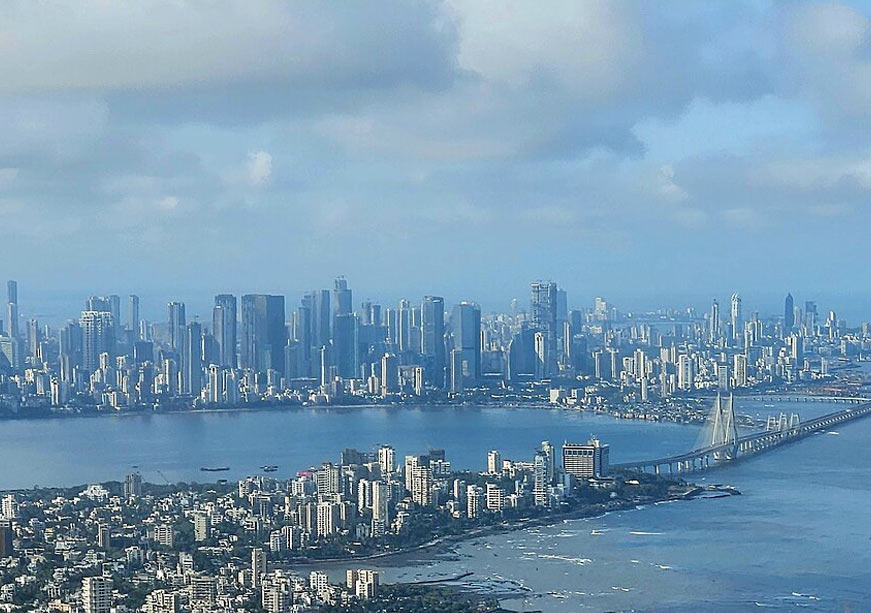-
CENTRES
Progammes & Centres
Location
Floating cities are emerging as ambitious responses to rising seas and urban pressures, but their future depends on whether they can overcome formidable environmental, engineering, and governance challenges

Once figments of science fiction, cities that float on the sea are now emerging as viable pursuits in climate adaptation and urban expansion strategies. Climate change and rising sea levels, which threaten to displace more than 2.4 billion people living within 100 km of the coast, have further fuelled their exploration.
From Japan’s Ocean Spiral and Dogen City, to The Netherlands’ Floating Future consortium, South Korea’s Oceanix, and Saudi Arabia’s Oxagon, do these ideas promise a new frontier of resilience and economic opportunity, pushing the boundaries of human endeavour and technological innovation? Do such conceptual designs highlight the innovative adaptability of floating cities, or are they merely an excuse to defer the hard choices required to manage emissions, land use, and social equity?
The Ocean Spiral, conceived by Japan’s Shimizu Corporation in 2014, envisions a spiral-shaped underwater city powered by deep-sea thermal gradients. In January 2024, Shimizu became part of the Floating Future consortium, led by the Netherlands’ Maritime Research Institute Netherlands (MARIN), to alleviate the rising sea level-induced land scarcity faced by the nation, nearly a third of whose landmass is below the mean sea level.
Floating cities aim to create flexible, relocatable infrastructure and circular economies that promise offshore climate-safe environments, which, while being close to metropolitan networks, simultaneously address the demographic challenges of an ageing population in Japan and several European nations.
Japanese design studios and marine technology start-ups have also proposed modular, semi-submersible platforms designed as floating archipelagos for aquaculture, renewable energy, healthcare, post-retirement settlements, and medical tourism.
In principle, the floating city concept aligns with the Sustainable Development Goals 11 (Sustainable Cities and Communities) and 13 (Climate Action), among others, to reduce pressure on scarce coastal areas without destroying inland habitats. Floating cities aim to create flexible, relocatable infrastructure and circular economies that promise offshore climate-safe environments, which, while being close to metropolitan networks, simultaneously address the demographic challenges of an ageing population in Japan and several European nations.
However, their technical, ecological and social implications must temper the optimism surrounding floating cities. Large-scale floating settlements require enormous quantities of steel, concrete, and composite materials, along with mooring systems to withstand typhoons, tsunamis, corrosion, biofouling, and structural fatigue. Even partial reclamation comes with enormous material demands, requiring dredging and sand mining, which are already raising global environmental and socioeconomic concerns, including displacement, delta destabilisation, biodiversity loss, and irreversible coastal erosion.
Japan’s Kansai International Airport, built in the 1990s on an artificial island in Osaka Bay, provides a sobering precedent. Once hailed as an engineering marvel, the island has been steadily sinking due to subsidence, forcing continuous, costly maintenance and soil stabilisation.
Even partial reclamation comes with enormous material demands, requiring dredging and sand mining, which are already raising global environmental and socioeconomic concerns, including displacement, delta destabilisation, biodiversity loss, and irreversible coastal erosion.
Elsewhere, too, extensive reclamation has had detrimental consequences. For example, extensive land reclamation has resulted in the erosion of large swaths of Singapore’s coastal forests and mangrove swamps. Similarly, Dubai’s spectacular seaward expansion has increased salinity, degraded marine species, and disrupted natural tidal currents.
The Dutch, meanwhile, succeeded with their age-old polder system[1], thanks to sustained technical innovation coupled with robust institutional mechanisms, dedicated funding, continuous monitoring, and an implicit social contract.
Without institutional and governance frameworks that consider their impact on vulnerable coastal communities, floating cities risk becoming enclaves of the privileged, disconnected from national priorities. Unless explicitly integrated into housing, labour, and environmental policies, floating cities could thus exacerbate inequality by catering to exclusive segments while leaving the coastal communities, especially small fishers and low-income groups, more vulnerable. Conversely, if aligned with adaptation objectives, they could provide enhanced social value by creating inclusive offshore habitats, easing pressure on shorelines and also housing.
Floating cities must also consider the fiscal trade-offs. The budgets, materials, and institutional mechanisms required for floating megaprojects are also necessary for on-land resilience and adaptation strategies.
The growing fascination with maritime urbanism is part of a broader global quest seeking to redefine urban living. For example, Saudi Arabia’s The Line, part of the futuristic NEOM development, is marketed as a car-free, 170-kilometre linear desert city powered by renewable energy, promising ultra-dense vertical living and digital governance. Yet, its scale has been sharply narrowed, due to fiscal and on-the-ground realities, as well as logistical complexities, forcing substantial recalibrations. Likewise, South Korea’s Songdo, a technologically endowed smart city conceived on 1,500 acres of reclaimed land from the Yellow Sea, remains incomplete, underpopulated, and criticised for its lack of social inclusion.
Across geographies, utopian megacities often yield uneven social benefits while imposing long-term environmental costs.
Unless explicitly integrated into housing, labour, and environmental policies, floating cities could thus exacerbate inequality by catering to exclusive segments while leaving the coastal communities, especially small fishers and low-income groups, more vulnerable.
On the other hand, India’s cities face unique and complex challenges from surging inbound migration, ever-increasing housing and infrastructure demand, limited fiscal resources, complex land politics, and intense monsoons, cyclones and heatwaves. The mixed fortunes of 920-sq-km Dholera Special Investment Region, with nearly 6,000 acres earmarked for urban development, and Amaravati illustrate both the potential and peril.
Dholera’s phased development demonstrates the value of incremental, infrastructure-first planning. Amaravati’s development as Andhra Pradesh’s new 217-sq km capital, however, was mired in political and land acquisition controversies that stalled momentum for over five years. The ambitious Lavasa project, touted as India’s first private city with a lifestyle akin to Italy’s Portofino, provides another example of how ill-conceived urban development can remain a utopian dream. Riddled with controversies since its launch, Lavasa is today mired in insolvency proceedings.
The challenges are even more complex for coastal or offshore developments along India’s densely populated and environmentally sensitive 11098.81-km coastline. Large-scale engineering solutions would have to navigate risks associated with cyclones, sea-level rise, fragile deltaic ecosystems, and vulnerable populations. Thus, any Indian experiment with floating or reclaimed settlements should be cautious and purpose-driven. A balanced national approach could involve:
Japan’s floating city ambitions and Saudi Arabia’s linear desert cities represent humanity’s quest to reimagine habitation in the face of growing ecological constraints. They are expressions of the same impulse driving lunar colonies and Martian settlements, seeking to unlock new frontiers of human habitats that had hitherto remained in the realms of science fiction.
Engineering ambition must balance environmental endurance by exploring floating urbanism not as an escape from terrestrial bounds but as a complement to them by advancing marine technologies, renewable hubs, and adaptive infrastructure that strengthen resilience both at sea and on land.
However, the lessons are grounded in reality. Engineering ambition must balance environmental endurance by exploring floating urbanism not as an escape from terrestrial bounds but as a complement to them by advancing marine technologies, renewable hubs, and adaptive infrastructure that strengthen resilience both at sea and on land.
A policy framework must, therefore, treat floating urbanism as an incremental technology pathway, prioritising utility before contemplating large human settlements. It must include lifecycle costs, such as maintenance funds, insurance guarantees, and ecological safeguards. Crucially, it must embed social inclusion, with non-negotiable mandates for affordable housing or accommodating displaced populations. Ignoring these principles will merely push land-based vulnerabilities out to sea.
For India and other coastal nations of the Global South, floating urbanism may one day supplement adaptation strategies. However, their immediate priority must be to fortify existing settlements by making them denser, cooler, safer, and more inclusive. For India, the proposed development of 12 greenfield cities under the National Industrial Corridor Development Programme presents a golden opportunity to expand its urban landscape sustainably and equitably.
In a century of rising seas and spiralling ambitions, floating cities may indeed play a role in humanity’s survival toolkit, but only if they are anchored in science, governance, and social purpose, rather than in fantasy.
Dhaval Desai is a Senior Fellow and Vice President at the Observer Research Foundation.
[1] Polders are large tracts of land, surrounded by dikes, with ground elevation below the mean sea level. Tidal gates or pumping control a polder’s water table.
The views expressed above belong to the author(s). ORF research and analyses now available on Telegram! Click here to access our curated content — blogs, longforms and interviews.

Dhaval is Senior Fellow and Vice President at Observer Research Foundation, Mumbai. His spectrum of work covers diverse topics ranging from urban renewal to international ...
Read More +